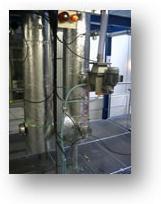Supercritical water gasification of wet biomass
Background
Supercritical water gasification (SCWG) is a promising technology for the efficient conversion of wet biomass (i.e., 60-95 weight-percent water) into syngas. The process takes place above the critical pressure and temperature of water. A feasibility study carried out has indicated that this technology would be technically and economically viable]. In a subsequent experimental study, the principle of supercritical gasification of real wet mineral-rich biomass was proved using a small-scale continuous experimental setup.Many organic waste streams, such as animal manure, sewage sludge and waste from the food industry, contain, besides water and organic matter, relatively high concentrations of inorganic elements such as minerals and metal elements (e.g., nitrates, phosphates, carbonates, halides, silicates, sulfides). Under supercritical conditions the solubility of minerals in water is drastically reduced, leading minerals to precipitate and crystallize in the supercritical gasification process. This can lead to agglomeration and ultimately clogging of the gasification process.
At supercritical conditions, the thermophysical properties of water (such as density, viscosity, thermal conductivity and specific heat capacity) are often orders of magnitude different with respect to subcritical conditions. Little is known about the fluid dynamic behavior of gasification reactors at supercritical conditions, but it is expected that these large differences strongly affect the hydrodynamic behavior. The formation of the various minerals during supercritical gasification of mineral-rich biomass is the second research topic and for two reasons. Firstly, the formation of minerals may affect hydrodynamic behavior, e.g., through distributions of particle size, shape and stickyness. Secondly, it is important to determine which minerals are formed. Furthermore, some minerals may influence the reaction kinetics and hence act as catalysts during the supercritical gasification process. However, little is known about the catalytic influence of minerals in supercritical gasification.
Objectives
1. Determining experimentally how the hydrodynamic behavior of the gasification reactor is affected at supercritical conditions and the consequences for gasification and crystallization.
This experimental work will involve carrying out flow measurements using a specially constructed experimental setup of a supercritical gasification reactor. The experimental results will be compared with results of numerical flow research lead by GENSOS.
2. Determining both theoretically and experimentally the formation and crystallization behavior of minerals in the supercritical gasification of mineral-rich organic waste streams, and the consequences for hydrodynamics and gasification.
This theoretical and experimental work and will involve the development of models for gasification/crystallization equilibrium and reaction kinetics and their validation by means of crystallization and gasification experiments using the aforementioned setup.
3. Determining, if possible, the catalytic behavior of relevant minerals during supercritical gasification and their influence on reaction kinetics.
Results should include fundamental knowledge and experimentally validated models of the hydrodynamics, crystallization and gasification behavior and their interactions. The ultimately aim of the novel knowledge and
models should be to facilitate the further development of the supercritical gasification process, providing the
required knowledge for, e.g., reactor-optimization and scale-up and mineral separation methods.

Chair:
Large-Scale Energy Storage
Involved People:
Prof.Dr.ir. Wiebren de Jong